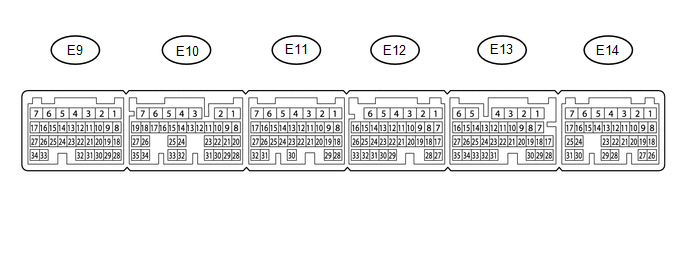Toyota Tacoma (2015-2018) Service Manual: Terminals Of Ecm
TERMINALS OF ECM

HINT:
The standard normal voltage between each pair of ECM terminals is shown in the table below. The appropriate conditions for checking each pair of terminals are also indicated. The result of checks should be compared with the standard normal voltage for that pair of terminals, displayed in the Specified Condition column. The illustration above can be used as a reference to identify the ECM terminal locations.
|
Terminal No. (Symbol) |
Wiring Color |
Terminal Description |
Condition |
Specified Condition |
|---|---|---|---|---|
|
E14-2 (BATT) - E11-1 (E1) |
L - W-B |
Battery (for measuring battery voltage and for ECM memory) |
Always |
11 to 14 V |
|
E12-6 (+BM) - E11-1 (E1) |
GR - W-B |
Power source of throttle actuator |
Always |
11 to 14 V |
|
E14-3 (+B) - E11-1 (E1) |
B - W-B |
Power source of ECM |
Ignition switch ON |
11 to 14 V |
|
E14-4 (+B2) - E11-1 (E1) |
B - W-B |
Power source of ECM |
Ignition switch ON |
11 to 14 V |
|
E14-25 (MREL) - E11-1 (E1) |
GR - W-B |
EFI-MAIN NO. 1 relay operation signal |
Ignition switch ON |
11 to 14 V |
|
E9-26 (VCNE) - E11-1 (E1) |
R - W-B |
Power source of crankshaft position sensor (specific voltage) |
Ignition switch ON |
4.5 to 5.5 V |
|
E9-25 (NE+) - E9-33 (NE-) |
B - G |
Crankshaft position sensor |
Idling |
Pulse generation |
|
E13-24 (SPD) - E11-1 (E1) |
R - W-B |
Vehicle speed signal from combination meter assembly |
Driving at 20 km/h (12 mph) |
Pulse generation |
|
E11-1 (E1) - Body ground |
W-B - Body ground |
Ground circuit of ECM |
Always |
Below 1 Ω |
 Diagnosis System
Diagnosis System
DIAGNOSIS SYSTEM
1. DESCRIPTION
(a) To check DTCs, connect the Techstream to the Data Link Connector 3 (DLC3)
of the vehicle. The Techstream displays DTCs and freeze frame data. The DTCs and
fre ...
 Check Mode Procedure
Check Mode Procedure
CHECK MODE PROCEDURE
1. DESCRIPTION
Check mode has a higher sensitivity to malfunctions and can detect malfunctions
that cannot be detected in normal mode. Check mode can also detect all of the ma ...
Other materials:
Precaution
PRECAUTION
1. IGNITION SWITCH EXPRESSIONS
(a) The type of ignition switch used on this model differs according to the specifications
of the vehicle. The expressions listed in the table below are used in this section.
Expression
Ignition Switch (Position)
Engine ...
Removal
REMOVAL
PROCEDURE
1. REMOVE REAR SEAT CUSHION ASSEMBLY
2. REMOVE NO. 4 ROOM PARTITION COVER LH
3. REMOVE NO. 4 ROOM PARTITION COVER RH
4. REMOVE NO. 3 ROOM PARTITION COVER
5. REMOVE BACK PANEL GARNISH HOLE PLUG
6. REMOVE BACK PANEL TRIM
7. REMOVE FRONT DOOR SCUFF PLATE ...
Rear Occupant Classification Sensor RH Collision Detection (B1788)
DESCRIPTION
DTC B1788 is set when the occupant detection ECU receives a collision detection
signal, which is sent by the occupant classification sensor rear RH when an accident
occurs.
DTC B1788 is also set when the front seat with adjuster frame assembly RH is
subjected to a strong impact, ...
